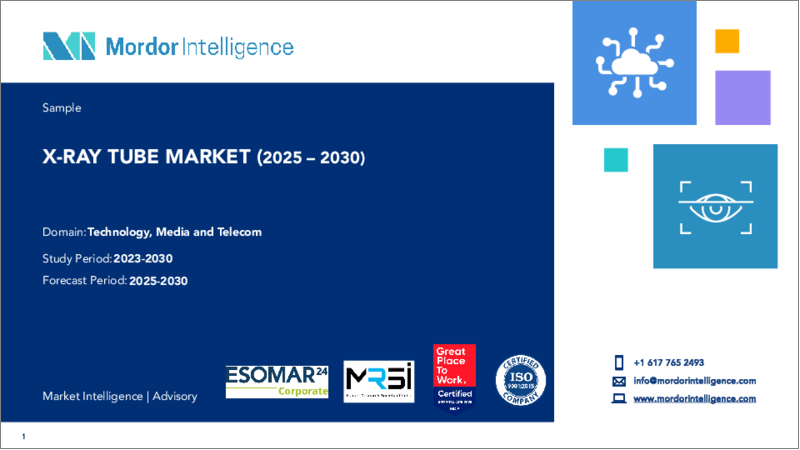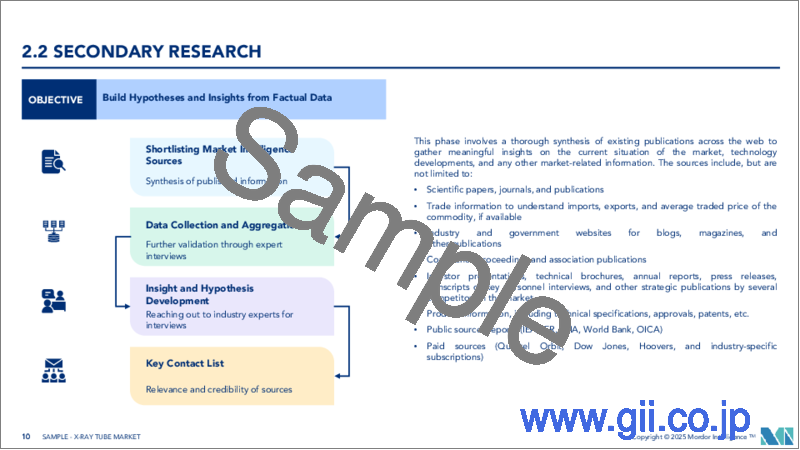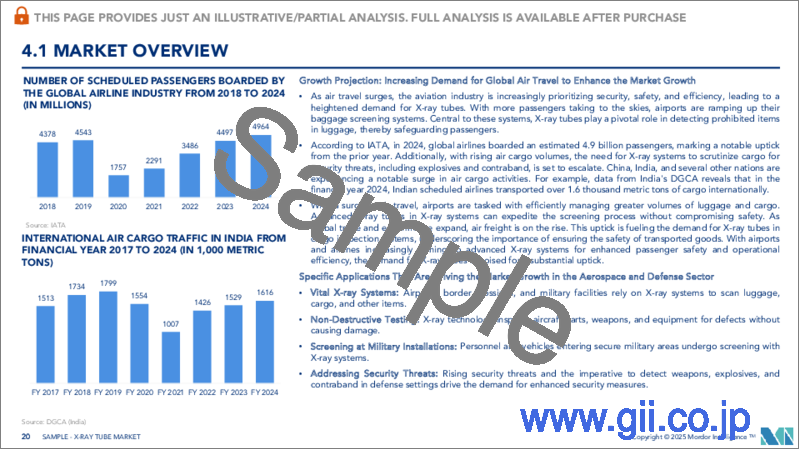|
|
市場調査レポート
商品コード
1686314
X線管- 市場シェア分析、産業動向・統計、成長予測(2025年~2030年)X-ray Tube - Market Share Analysis, Industry Trends & Statistics, Growth Forecasts (2025 - 2030) |
||||||
カスタマイズ可能
適宜更新あり
|
|||||||
| X線管- 市場シェア分析、産業動向・統計、成長予測(2025年~2030年) |
|
出版日: 2025年03月18日
発行: Mordor Intelligence
ページ情報: 英文 120 Pages
納期: 2~3営業日
|
- 全表示
- 概要
- 目次
X線管市場規模は2025年に36億3,000万米ドル、2030年には44億5,000万米ドルに達すると予測、予測期間(2025年~2030年)のCAGRは4.19%。

主なハイライト
- X線は、セキュリティ、冶金、非破壊検査、その他の産業用途に応用されています。技術の進歩は、この市場の成長を促進する主な要因の1つです。過去数十年の間に、X線の用途は医療分野を超えて飛躍的に拡大しました。
- 電子技術の革新により、X線装置のサイズは大幅に縮小しました。コンパクトなシステムが利用可能になったことで、X線装置は空港のセキュリティ、手荷物スキャン、冶金用途などさまざまな分野で使用されるようになりました。さらに、世界の医療事件や事故による傷害の増加が、調査対象市場の成長に影響を与えています。
- 例えば、Excillum社は最近、新世代の高解像度X線管の開発を発表しました。Excillum社のNanoTube N3は、当初3種類のバージョンで提供され、160kVまでの世界最高の解像度を可能にします。ナノチューブN3は、自動車、航空宇宙、医療、エレクトロニクス、半導体バックエンドなどの先端産業の計測および非破壊検査(NDT)コンポーネントをターゲットとしています。
- パンデミック(世界的大流行)のシナリオは、医療とヘルスケア・アプリケーションに大きな恩恵をもたらしました。COVID-19に関連する症状があるかどうかを確認するための主要な検査方法として、CTおよびX線画像が世界的に確立されています。シーメンス・ヘルスイニアーズによると、複数の研究者が実施した調査では、X線検査ではCOVID-19関連の肺陰影に対する感度が25%~69%と低いことが判明しました。
- 近い将来、アジア太平洋や北米のような需要の高い地域では、安全規制が見直され、規則や工業規格が厳しくなることが予想されます。このシナリオは、新規参入を困難にします。そのため、厳しい規制や有効なガイドラインが市場の成長を抑制しています。
X線管市場の動向
ヘルスケア分野が最大の市場シェアを占める
- 医療分野では、より小型で短時間のスキャンを必要とする歯科用途で、据置型X線管による撮影が行われています。リステリン・プロフェッショナルによると、口腔疾患は最も一般的な健康問題であり、世界中で推定39億人が罹患しています。したがって、歯科分野では、回転陽極X線管を必要としないX線撮影の主な需要は、撮影目的に適した据置型X線管によるものです。
- ここ数年、インターベンショナルX線における重要な進歩のひとつは、放射線量を増加させることなく、高画質で高解像度の画像を提供するためのコア技術やサポート技術に注目が集まっていることです。これは、シーメンスのArtis Q、フィリップスのClarityIQ技術、Q.zen技術、GEヘルスケアの画像誘導システム(IGS)、東芝のInfinix Elite製品ラインなどの技術進歩を支える重要な原動力となっています。
- 医療機器業界では、放射線診断検査への注目の高まり、慢性疾患負担の増加、市場統合や合併による効率的なX線装置の導入など、さまざまな要因により、毎年画像診断検査件数が増加しています。
- 国連の世界人口見通し(World Population Prospects)のデータによると、65歳以上の人口は着実に増加しています。2050年までに、世界の60歳以上の人口は20億人に達すると予測され、そのうち80%は低・中所得国に住む可能性があります。したがって、老人人口の増加と整形外科手術や心臓血管手術の増加が、医療用X線管の採用をさらに促進する可能性があります。
- X線はX線管を使って発生させるが、製薬業界では、特にマンモグラフィーの用途でより軟らかいX線が必要な場合、これらのX線管はタングステンと共に使用されます。研究に使用される特殊なX線源は放射光として知られ、高倍率のX線管が使用される粒子加速器の放射線プロセスによって生成されます。
北米が大きなシェアを占める
- 米国では老年人口が増加し、座りがちな生活や不健康な食習慣のために慢性疾患が急増しています。国勢調査のデータによると、昨年7月現在、米国人口3億2,800万人の16.5%、すなわち5,400万人が65歳以上です。2030年には7,400万人に増えると推定されています。85歳以上の人口はさらに増加します。さらに、医療施設の増加に伴う医療インフラの開発が、アメリカの医療用X線管市場の需要を促進すると予想されています。
- 例えば、医療機器メーカーであるEOSイメージング社は、米国ニューヨークにある特殊外科病院(HSS)に4台目のEOSシステムを設置し、機能的な姿勢の患者の低線量全身立体X線画像を提供しています。
- さらに、米国だけでも、慢性疾患患者による救急外来受診の30%以上が予防可能であり、その結果、毎年90億米ドル以上の回避可能なコストが発生しています。慢性疾患の増加は、適切かつタイムリーな治療とケアのためのスクリーニング技術の重要性を押し上げています。X線検査は、膵外分泌、肺、骨、腹部などの慢性疾患の診断に重要な役割を果たし続けています。
- また、X線管は検査目的でも、この地域で大幅に導入されています。麻薬取締局(DFA)によると、フェンタニル、ヘロイン、メタンフェタミンのほとんどは南西国境を越えて密輸されています。それは主に合法的な入国港から米国に密輸され、i.税関・国境警備局(CBP)職員の足元まで入ってくる。さらに、CBPは現在、陸路国境でスキャンしているのは、自家用乗用車のわずか2%、商用車の16%にすぎないと認めています。
- 空港警備もX線システムの主要ユーザーです。例えば、TSAは最近、TSA検問所用の中型コンピューター断層撮影X線システムの調達について、アナロジック・コーポレーションに1億9,800万米ドルの発注を行いました。
X線管業界の概要
この業界では、大手企業の存在が競争企業間の敵対関係を支配しています。差別化された製品へのニーズの高まりにより、市場はイノベーションを通じて持続可能な競争優位性を獲得することができます。例えば、2022年1月、フォートレス・テクノロジー社は、食品パック用ラプターと名付けられた新しいX線管を発売しました。ラプターX線は、金属、ガラス、木材、ゴム、高密度プラスチック、石、石灰化した骨を含む肉、チーズ、チルド、菓子類の包装製品を検査し、不合格にします。
2022年5月、ヘルスケアAIソリューションのプロバイダーであるAidocは、放射線医学におけるAI技術の活用に注力するフランスのMedTech企業であるGleamerと、GleamerのX線用BoneViewsolutionを統合することで合意したと発表しました。GleamerのAI BoneViewX-rayソリューションの搭載は、AidocのX線モダリティへの進出を拡大することを目的としています。
2022年3月、キヤノンメディカルシステムズ株式会社は、診断用X線装置を開発・製造する高度な技術を持つデンマークのNordisk Rontgen Teknik A/S社を買収する契約を締結したと発表しました。この買収により、キヤノンメディカルシステムズは、欧州を拠点とする先端画像ソリューションの技術、開発、製造へのアクセスを獲得しました。
2022年1月、マルバーンはCreoptixAGを買収し、親和性の高い製品を強化・拡大しました。Creoptixは、分析装置、ソフトウェア、消耗品を開発・製造する動力学測定会社です。マルバーン・パナリティカル社の膨大な顧客基盤を活用することで、このパートナーシップは、スピードと感度の面でCreoptix社の優れた技術を迅速にスケールアップするエキサイティングな可能性を示しています。
その他の特典:
- エクセル形式の市場予測(ME)シート
- 3ヶ月間のアナリストサポート
目次
第1章 イントロダクション
- 調査の前提条件と市場定義
- 調査範囲
第2章 調査手法
第3章 エグゼクティブサマリー
第4章 市場洞察
- 市場概要
- 産業バリューチェーン分析
- 業界の魅力度-ポーターのファイブフォース分析
- 供給企業の交渉力
- 消費者の交渉力
- 新規参入業者の脅威
- 代替品の脅威
- 競争企業間の敵対関係
- 技術スナップショット
- イントロダクション
- X線管の主要部品
- エンベロープ
- 陰極
- 陽極
- 保護ハウジング
第5章 市場力学
- 市場促進要因
- 技術の進歩
- ヘルスケア診断の需要増加
- 市場抑制要因
- 厳しい規制と検証ガイドライン
第6章 市場セグメンテーション
- タイプ
- 回転陽極管
- 据置型X線管
- エンドユーザー産業
- 製造業
- ヘルスケア
- 食品
- 航空宇宙・防衛
- その他のエンドユーザー産業
- 地域
- 北米
- 米国
- カナダ
- 欧州
- 英国
- ドイツ
- フランス
- その他の欧州
- アジア太平洋
- 中国
- 日本
- インド
- その他のアジア太平洋
- 世界のその他の地域
- 北米
第7章 競合情勢
- 企業プロファイル
- Varex Imaging Corporation
- YXLON International
- Lafco India Scientific Industries
- Malvern Panalytical Ltd
- Proto Manufacturing
- Oxford Instruments PLC
- General Electric Company
- Koninklijke Philips NV
- Comet Group
- Canon Electron Tubes & Devices Co. Ltd(CANON Inc.)
- Siemens AG
第8章 投資分析
第9章 市場機会と今後の動向
The X-ray Tube Market size is estimated at USD 3.63 billion in 2025, and is expected to reach USD 4.45 billion by 2030, at a CAGR of 4.19% during the forecast period (2025-2030).

Key Highlights
- X-rays have found applications in security, metallurgy, non-destructive testing, and other industrial applications. Technological advancement is one of the primary factors driving the growth of the market studied. Over the past few decades, the application of X-rays has drastically expanded beyond the field of medicine.
- With electronic innovations, these systems' sizes have significantly decreased. With the availability of compact systems, X-ray machines are now used in various fields, such as airport security, baggage scanning, and metallurgical applications. In addition, increasing medical cases and accidental injuries worldwide are influencing the growth of the market studied.
- For instance, recently, Excillum launched its latest development-a new generation of high-resolution X-ray tubes. The Excillum NanoTube N3, initially available in 3 different versions, enables the world's best resolution up to 160 kV. The NanoTube N3 targets advanced industries' metrology and non-destructive testing (NDT) components, e.g., automotive, aerospace, medical, electronics, and semiconductor back ends.
- The pandemic scenario benefited medical and healthcare applications greatly. Several associations and governing bodies have globally established CT and X-ray imaging as a primary mode of examination to check a patient for the presence of COVID-19-related symptoms. According to Siemens Healthineers, the studies conducted by multiple researchers found that the X-ray examinations had a lower sensitivity for COVID-19-related lung shadowing of 25% to 69%.
- In the near future, the high-demand regions, such as Asia-Pacific and North America, are expected to revise their safety regulations, leading to stricter rules and industrial standards. This scenario also makes it hard for new players to enter the market. Therefore, stringent regulations and validatory guidelines restrain the market's growth.
X-Ray Tube Market Trends
Healthcare Sector Holds the Largest Market Share
- In the medical sector, dental applications that require smaller and shorter scans are found to be using stationary x-ray tubes for imaging. Oral conditions are the most common health issues, affecting an estimated 3.9 billion people worldwide, according to Listerine Professional.Therefore, in the dental sector, the primary demand for x-ray imaging, which does not require rotating anode x-ray tubes, is due to stationary tubes that are suitable for imaging purposes.
- Many advances in medical radiation equipment and techniques have been seen as a result of technological advancements and increased adoption of technology in the healthcare industry.Over the past few years, one of the significant advancements in interventional x-ray has been an increased focus on core and supporting technologies to provide high-quality, high-resolution images without a corresponding increase in radiation dose. This has been a key driver behind technology advancements such as Siemens' Artis Q, Philips' ClarityIQ technology, Q.zen technology, GE Healthcare's Image Guided Systems (IGS), and Toshiba's Infinix Elite product line.
- The medical devices industry is witnessing a growth in the number of imaging and diagnostic tests performed every year owing to various factors, such as an increasing focus on radiological diagnostic tests, rising chronic disease burdens, and the introduction of efficient X-ray devices through market consolidation and mergers.
- The number of people over the age of 65 is steadily increasing, according to UN data from the World Population Prospects.By 2050, the world's population aged 60 years and older is predicted to reach 2 billion, of which 80% may live in low- and middle-income countries. Hence, the rising geriatric population and the increasing number of orthopedic and cardiovascular procedures may further drive the adoption of X-ray tubes in medical applications.
- The x-rays are generated using the x-ray tubes, and in the pharmaceutical industry, these tubes are used with tungsten, especially when softer x-rays are required in mammography applications. The specialized x-ray sources used in the research are known as synchrotron radiation, generated by the radiation process in particle accelerators in which high-magnitude x-ray tubes are used.
North America Accounts for a Significant Share
- The United States is witnessing an increase in the geriatric population as well as a surge in the incidence of chronic diseases because of sedentary lifestyles and unhealthy eating habits. According to census data, as of July last year, 16.5% of the US population of 328 million people, i.e., 54 million, were over the age of 65. It is estimated that by 2030, the number will increase to 74 million. The number of people over the age of 85 is growing even faster. Moreover, rising medical infrastructure developments with the increase in medical facilities are expected to propel the demand for the medical X-ray tube market in America.
- For instance, EOS imaging, a medical device company, has installed its fourth EOS system at the Hospital for Special Surgery (HSS) in New York City, United States, which offers low-dose full-body, stereo-radiographic images of a patient in a functional position.
- Additionally, in the United States alone, over 30% of emergency department visits by the chronically ill are preventable, resulting in avoidable costs of over USD 9 billion each year. The rise in chronic diseases is pushing up the importance of screening techniques for the right and timely treatment and care. X-ray continues to play a vital role in chronic disease diagnosis, like diseases of the exocrine pancreas, lungs, bones, and abdomen.
- Also, the X-ray tube is being deployed significantly in the region for inspection purposes. According to the Drug Enforcement Administration (DFA), most of the fentanyl, heroin, and methamphetamine are trafficked across the southwest border. It is primarily smuggled into the United States through legal ports of entry, i.e., it comes within feet of the Customs and Border Protection (CBP) officer. Additionally, CBP has acknowledged that it currently scans only 2% of all private passenger vehicles and 16% of commercial vehicles at land borders.
- Airport security is also a major user of X-ray systems. For instance, recently, the TSA awarded an order worth USD 198 million to Analogic Corporation for the procurement of mid-sized computed tomography X-ray systems for TSA checkpoints.
X-Ray Tube Industry Overview
The presence of major players governs competitive rivalry in this industry. The market can attain a sustainable competitive advantage through innovation, owing to the growing need for differentiated products. For instance, in January 2022, Fortress Technology launched a new x-ray tube named raptor for food packs. The Raptor X-Ray inspects and rejects packaged meat, cheese, chilled, and confectionery products with metal, glass, wood, rubber, high-density plastic, stone, and calcified bones.
In May 2022, Aidoc, a provider of healthcare AI solutions, announced an agreement with Gleamer, a French MedTech company focused on using AI technology in radiology to integrate Gleamer's BoneViewsolution for X-rays. The onboarding of Gleamer's AI BoneViewX-ray solution aimed to expand Aidoc's venture into the X-ray modality.
In March 2022, Canon Medical Systems Corporation announced that it entered an agreement to acquire Nordisk Rontgen Teknik A/S, a Danish company with advanced technology for developing and manufacturing diagnostic X-ray systems. Through this acquisition, Canon Medical opened up access to European-based technology, development, and manufacturing for advanced imaging solutions.
In January 2022, Malvern acquired CreoptixAG in order to strengthen and expand its affinity offering. Creoptixis a kinetics measuring company that develops and manufactures analytical equipment, software, and consumables. By leveraging Malvern Panalytical'senormous client base, the partnership presents an exciting potential to quickly scale Creoptix'ssuperior technology in terms of speed and sensitivity.
Additional Benefits:
- The market estimate (ME) sheet in Excel format
- 3 months of analyst support
TABLE OF CONTENTS
1 INTRODUCTION
- 1.1 Study Assumptions and Market Definition
- 1.2 Scope of the Study
2 RESEARCH METHODOLOGY
3 EXECUTIVE SUMMARY
4 MARKET INSIGHTS
- 4.1 Market Overview
- 4.2 Industry Value Chain Analysis
- 4.3 Industry Attractiveness - Porter's Five Forces Analysis
- 4.3.1 Bargaining Power of Suppliers
- 4.3.2 Bargaining Power of Consumers
- 4.3.3 Threat of New Entrants
- 4.3.4 Threat of Substitutes
- 4.3.5 Intensity of Competitive Rivalry
- 4.4 Technology Snapshot
- 4.4.1 Introduction
- 4.4.2 Major Components of X-ray Tube
- 4.4.2.1 Envelope
- 4.4.2.2 Cathode
- 4.4.2.3 Anode
- 4.4.2.4 Protective housing
5 MARKET DYNAMICS
- 5.1 Market Drivers
- 5.1.1 Technological Advancements
- 5.1.2 Increasing Demand for Healthcare Diagnostics
- 5.2 Market Restraints
- 5.2.1 Stringent Regulations and Validatory Guidelines
6 MARKET SEGMENTATION
- 6.1 Type
- 6.1.1 Rotating Anode Tube
- 6.1.2 Stationary X-Ray Tube
- 6.2 End-user Industry
- 6.2.1 Manufacturing
- 6.2.2 Healthcare
- 6.2.3 Food
- 6.2.4 Aerospace and Defense
- 6.2.5 Other End-user Industries
- 6.3 Geography
- 6.3.1 North America
- 6.3.1.1 United States
- 6.3.1.2 Canada
- 6.3.2 Europe
- 6.3.2.1 United Kingdom
- 6.3.2.2 Germany
- 6.3.2.3 France
- 6.3.2.4 Rest of Europe
- 6.3.3 Asia-Pacific
- 6.3.3.1 China
- 6.3.3.2 Japan
- 6.3.3.3 India
- 6.3.3.4 Rest of Asia-Pacific
- 6.3.4 Rest of the World
- 6.3.1 North America
7 COMPETITIVE LANDSCAPE
- 7.1 Company Profiles
- 7.1.1 Varex Imaging Corporation
- 7.1.2 YXLON International
- 7.1.3 Lafco India Scientific Industries
- 7.1.4 Malvern Panalytical Ltd
- 7.1.5 Proto Manufacturing
- 7.1.6 Oxford Instruments PLC
- 7.1.7 General Electric Company
- 7.1.8 Koninklijke Philips NV
- 7.1.9 Comet Group
- 7.1.10 Canon Electron Tubes & Devices Co. Ltd (CANON Inc.)
- 7.1.11 Siemens AG






